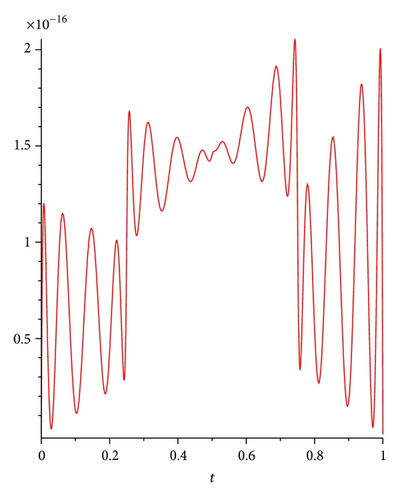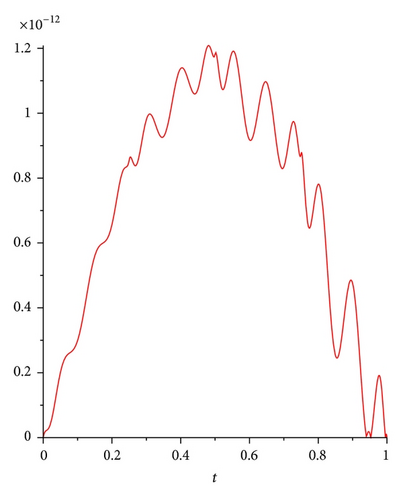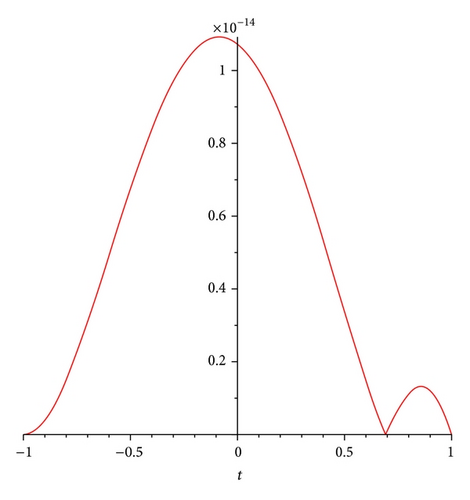On Solution of Fredholm Integrodifferential Equations Using Composite Chebyshev Finite Difference Method
Abstract
A new numerical method is introduced for solving linear Fredholm integrodifferential equations which is based on a hybrid of block-pulse functions and Chebyshev polynomials using the well-known Chebyshev-Gauss-Lobatto collocation points. Composite Chebyshev finite difference method is indeed an extension of the Chebyshev finite difference method and can be considered as a nonuniform finite difference scheme. The main advantage of the proposed method is reducing the given problem to a set of algebraic equations. Some examples are given to approve the efficiency and the accuracy of the proposed method.
1. Introduction
Linear and nonlinear Fredholm integrodifferential equations can be used to model many problems of science and theoretical physics such as engineering, biological models, electrostatics, control theory of industrial mathematics, economics, fluid dynamics, heat and mass transfer, oscillation theory, and queuing theory [1].
In recent years, many authors have considered different numerical methods to solve these kinds of problems. In 2012, Dehghan and Salehi employed [2] the meshless moving least square method for solving nonlinear Fredholm integrodifferential equations. A sequential method for the solution of Fredholm integrodifferential equations was presented by Berenguer et al. [3] in 2012. The formulation of the Fredholm integrodifferential equation in terms of an operator and the use of Schauder bases are the main tools of this method.
In [4], the operational Adomian-Tau method with Pade approximation was used for solving nonlinear Fredholm integrodifferential equations. This approach is based on two matrices, and Pade approximation was used to improve the accuracy of the method. Chebyshev finite difference method was proposed in [5] in order to solve Fredholm integrodifferential equations. In this scheme the problem is reduced to a set of algebraic equations. In [6], Legendre collocation matrix method was introduced for solving high-order linear Fredholm integrodifferential equations. In this way, the equation and its conditions are converted to matrix equations using collocation points on the interval [−1,1]. Atabakan et al. [7, 8] proposed a modification of homotopy analysis method (HAM) known as spectral homotopy analysis method (SHAM) to solve linear Volterra and Fredholm integrodifferential equations. In this procedure, the Chebyshev pseudospectral method was used to obtain an approximation of solutions to higher-order equation. The semiorthogonal spline method was discussed in [9]. This approach is used to solve Fredholm integral and integrodifferential equations.
The base of the proposed method is a hybrid of block-pulse functions and Chebyshev polynomials using Chebyshev-Gauss-Lobatto points. This method was introduced and applied for solving the optimal control of delay systems with a quadratic performance index in [10, 11].
Chebyshev polynomials which are the eigenfunctions of a singular Sturm-Liouville problem have many advantages. They can be considered as a good representation of smooth functions by finite Chebyshev expansions provided that the function is infinitely differentiable. The Chebyshev expansion coefficients converge faster than any finite power of 1/m as m goes to infinity for problems with smooth solutions. The numerical differentiation and integration can be performed. Moreover, they have been applied to solve different kinds of boundary value problems [12–14].
The paper is organized in the following way. Section 2 includes some necessary preliminaries and notations. Chebyshev finite difference method and composite Chebyshev finite difference method for solving Fredholm integrodifferential equations are described in Sections 3 and 4, respectively. Convergence analysis of the proposed method is presented in Section 5. In Section 6 discretization of the method is introduced, and some numerical examples are presented in Section 7. In Section 8, concluding remarks are given.
2. Preliminaries and Notations
In this section, we present some notations, definitions, and preliminary facts that will be used further in this work.
2.1. Block-Pulse Functions (BPF)
2.2. Chebyshev Polynomials
2.3. Hybrid Functions of Block-Pulse and Chebyshev Polynomials
3. Chebyshev Finite Difference Method
As can be seen from (23), the first three derivatives of the function f(t) at any point of the Chebyshev-Gauss-Lobatto points is expanded as a linear combination of the values of the function at these points.
4. Composite Chebyshev Finite Difference Method
5. Convergence Analysis
A detailed proof of the following results can be found in [11].
Lemma 1. If the hybrid expansion of a continuous function h(t) converges uniformly, then it converges to the function h(t).
Theorem 2. A function with bounded second derivative, say |h′′(t)| ≤ B, can be expanded as an infinite sum of hybrid functions and the series converges uniformly to h(t), that is,
Theorem 3. Suppose that with bounded second derivative, say |h′′(t)| ≤ B, and then its hybrid expansion converges uniformly to h(t); that is,
Theorem 4 (accuracy estimation). Suppose that with bounded second derivative, say |h′′(t)| ≤ B, and then one has the following accuracy estimation:
6. Discretization of Problem
7. Numerical Examples
In this section, we apply the technique described in Section 6 to some illustrative examples of higher-order linear Fredholm integrodifferential equations.
Example 1. Consider the second-order Fredholm integrodifferential equation [5, 15]
We solve the problem with M = 10, and K = 8. A comparison between absolute errors in solutions obtained by composite Chebyshev finite difference method, wavelet collocation method, wavelet Galerkin and Chebyshev finite difference method is tabulated in Table 1. As can been seen in Table 1, our results are much more accurate than those K obtained by other methods specially wavelet collocation method.
| x | Wavelet collocation [15] | Wavelet Galerkin [15] | Chebyshev finite difference [5] | Present method |
|---|---|---|---|---|
| 0.125 | 9.3 × 10−4 | 7.9 × 10−7 | 2.1 × 10−9 | 1.16 × 10−15 |
| 0.250 | 1.6 × 10−3 | 1.3 × 10−6 | 2.0 × 10−8 | 2.28 × 10−15 |
| 0.375 | 2.0 × 10−3 | 1.6 × 10−6 | 1.8 × 10−7 | 1.27 × 10−15 |
| 0.500 | 1.9 × 10−3 | 1.6 × 10−6 | 1.9 × 10−8 | 3.15 × 10−16 |
| 0.625 | 1.6 × 10−3 | 1.5 × 10−6 | 1.9 × 10−7 | 2.79 × 10−17 |
| 0.750 | 1.1 × 10−3 | 1.1 × 10−6 | 4.9 × 10−8 | 1.63 × 10−16 |
| 0.875 | 5.5 × 10−4 | 6.5 × 10−7 | 4.2 × 10−8 | 1.52 × 10−15 |
| K | 4 | 10 | 8 |
|---|---|---|---|
| M | 8 | 8 | 10 |
| EKM | 6.66 × 10−10 | 3.01 × 10−13 | 2.28 × 10−15 |
Example 2. Consider the second-order Fredholm integrodifferential equation [5, 15]
The problem is solved with M = 7, and K = 8. A comparison between absolute errors in solutions by composite Chebyshev finite difference method, wavelet collocation method, wavelet Galerkin and Chebyshev finite difference method is tabulated in Table 3. It is clear from Table 3 that our method is reliable and applicable to handle Fredholm integrodifferential equations. For different values of K, the errors of EKM are shown in Table 4.
| x | Wavelet collocation [15] | Wavelet Galerkin [15] | Chebyshev finite difference [5] | Present method |
|---|---|---|---|---|
| 0.125 | 2.6 × 10−2 | 2.7 × 10−4 | 1.8 × 10−10 | 1.45 × 10−15 |
| 0.250 | 1.5 × 10−2 | 3.0 × 10−5 | 4.4 × 10−10 | 1.78 × 10−15 |
| 0.375 | 9.3 × 10−3 | 2.6 × 10−4 | 1.4 × 10−9 | 1.71 × 10−15 |
| 0.500 | 5.1 × 10−3 | 4.3 × 10−4 | 2.4 × 10−10 | 5.00 × 10−15 |
| 0.625 | 2.5 × 10−3 | 5.6 × 10−4 | 1.7 × 10−9 | 1.22 × 10−15 |
| 0.750 | 1.0 × 10−3 | 6.5 × 10−4 | 7.7 × 10−10 | 8.66 × 10−16 |
| 0.875 | 2.3 × 10−4 | 7.2 × 10−4 | 1.3 × 10−9 | 4.52 × 10−16 |
| K | 8 | 10 | 8 |
|---|---|---|---|
| M | 6 | 6 | 7 |
| EKM | 6.01 × 10−13 | 8.72 × 10−14 | 1.22 × 10−15 |
Example 3. Consider the second-order Fredholm integrodifferential equation [5, 16]
| x | Exact solution | Tau method [16] | Chebyshev finite difference [5] | Present method |
|---|---|---|---|---|
| −1.0 | 0.367879441 | 1.52 × 10−6 | 1.19 × 10−8 | 1.32 × 10−16 |
| −0.8 | 0.449328964 | 1.74 × 10−6 | 1.33 × 10−8 | 1.36 × 10−16 |
| −0.6 | 0.548811636 | 1.95 × 10−6 | 1.29 × 10−8 | 1.38 × 10−16 |
| −0.4 | 0.670320046 | 2.02 × 10−6 | 1.43 × 10−8 | 1.40 × 10−16 |
| 0.2 | 0.818730753 | 1.97 × 10−6 | 1.27 × 10−8 | 1.20 × 10−16 |
| 0.0 | 1.000000000 | 1.83 × 10−6 | 1.02 × 10−8 | 9.99 × 10−16 |
| 0.2 | 1.221402758 | 1.63 × 10−6 | 1.04 × 10−8 | 7.91 × 10−17 |
| 0.4 | 1.491824698 | 1.36 × 10−6 | 8.68 × 10−9 | 7.31 × 10−17 |
| 0.6 | 1.822118800 | 1.04 × 10−6 | 2.92 × 10−9 | 3.08 × 10−17 |
| 0.8 | 2.225540928 | 5.56 × 10−7 | 1.65 × 10−9 | 3.69 × 10−17 |
| 1.0 | 2.718281828 | 1.52 × 10−6 | 1.19 × 10−8 | 1.32 × 10−16 |
| K | 4 | 10 | 8 |
|---|---|---|---|
| M | 8 | 8 | 10 |
| EKM | 4.07 × 10−12 | 3.93 × 10−15 | 2.79 × 10−17 |
Example 4. Consider the first-order Fredholm integrodifferential equation [3, 17–19]
| x | CAS wavelet method [17] | DT method [18] | Improved homotopy perturbation [19] | Sequential approach [3] | Present method |
|---|---|---|---|---|---|
| 0.1 | 1.34 × 10−3 | 1.00 × 10−2 | 0.23 × 10−5 | 1.01 × 10−7 | 1.25 × 10−17 |
| 0.2 | 1.15 × 10−3 | 2.78 × 10−2 | 0.92 × 10−5 | 4.82 × 10−7 | 4.27 × 10−17 |
| 0.3 | 5.67 × 10−3 | 5.08 × 10−2 | 0.20 × 10−4 | 1.017 × 10−6 | 1.46 × 10−16 |
| 0.4 | 5.93 × 10−2 | 7.08 × 10−2 | 0.37 × 10−4 | 1.61 × 10−6 | 1.53 × 10−16 |
| 0.5 | 1.32 × 10−2 | 9.71 × 10−2 | 0.57 × 10−4 | 2.30 × 10−6 | 1.44 × 10−16 |
| 0.6 | 4.39 × 10−2 | 1.09 × 10−1 | 0.83 × 10−4 | 3.09 × 10−6 | 1.68 × 10−16 |
| 0.7 | 1.41 × 10−2 | 1.04 × 10−1 | 0.11 × 10−3 | 3.97 × 10−6 | 1.74 × 10−16 |
| 0.8 | 1.34 × 10−2 | 6.94 × 10−2 | 0.14 × 10−3 | 4.90 × 10−6 | 5.40 × 10−17 |
| 0.9 | 1.32 × 10−2 | 1.00 × 10−2 | 0.18 × 10−3 | 6.13 × 10−6 | 1.72 × 10−17 |

Example 5. Consider the first-order Fredholm integrodifferential equation [6, 34, 35]
| x | Legendre polynomial solutions [6] | Present method |
|---|---|---|
| −1.0 | 1.00 × 10−8 | 0 |
| −0.8 | 1.00 × 10−8 | 2.98 × 10−13 |
| −0.6 | 0.00 | 6.56 × 10−13 |
| −0.4 | 1.00 × 10−8 | 9.80 × 10−13 |
| −0.2 | 0.00 | 1.13 × 10−13 |
| 0.0 | 0.00 | 1.18 × 10−12 |
| 0.2 | 1.00 × 10−8 | 9.18 × 10−12 |
| 0.4 | 0.00 | 8.34 × 10−13 |
| 0.6 | 2.00 × 10−8 | 7.80 × 10−13 |
| 0.8 | 4.60 × 10−7 | 4.75 × 10−13 |
| 1.0 | 5.25 × 10−6 | 0 |

Example 6. Consider the third-order linear Fredholm integrodifferential equation [6]
| x | Exact solution | Legendre polynomial solutions [6] | Present method |
|---|---|---|---|
| −1.0 | −0.8414709848 | 4.39 × 10−9 | 7.00 × 10−20 |
| −0.8 | −0.7173560909 | 4.69 × 10−9 | 1.50 × 10−15 |
| −0.6 | −0.5646424734 | 1.19 × 10−9 | 4.91 × 10−15 |
| −0.4 | −0.3894183423 | 2.30 × 10−9 | 8.38 × 10−15 |
| −0.2 | −0.1986693308 | 9.50 × 10−11 | 1.05 × 10−14 |
| 0.0 | 0.0 | 1.99 × 10−17 | 1.07 × 10−14 |
| 0.2 | 0.1986693308 | 1.04 × 10−10 | 8.79 × 10−15 |
| 0.4 | 0.3894183423 | 1.06 × 10−8 | 5.34 × 10−15 |
| 0.6 | 0.5646424734 | 5.00 × 10−8 | 1.48 × 10−15 |
| 0.8 | 0.7173560909 | 1.35 × 10−6 | 1.11 × 10−15 |
| 1.0 | 0.8414709848 | 4.65 × 10−7 | 7.00 × 10−20 |
| K | 4 | 5 | 9 | 10 |
|---|---|---|---|---|
| M | 5 | 5 | 8 | 9 |
| EKM | 4.13 × 10−6 | 3.32 × 10−6 | 3.77 × 10−14 | 1.07 × 10−14 |

8. Conclusion
In this paper, we presented the composite Chebyshev finite difference method for solving Fredholm integrodifferential equations. The composite ChFD method is indeed an extension of the ChFD scheme with K = 1. This method is based on a hybrid of block-pulse functions and Chebyshev polynomials using Chebyshev-Gauss-Lobatto collocation points.
The useful properties of Chebyshev polynomials and block-pulse functions make it a computationally efficient method to approximate the solution of Fredholm integrodifferential equations. We converted the given problem to a system of algebraic equations using collocation points.
The main advantage of the present method is the ability to represent smooth and especially piecewise smooth functions properly. It was also shown that the accuracy can be improved either by increasing the number of subintervals or by increasing the number of collocation points in subintervals. Several examples have been provided to demonstrate the powerfulness of the proposed method. A comparison was made among the present method, some other well-known approaches, and exact solution which confirms that the introduced method is more accurate and efficient.
Acknowledgment
The authors express their sincere thanks to the referees for the careful and detailed reading of the earlier version of the paper and very helpful suggestions. The authors also gratefully acknowledge that this research was partially supported by the Universiti Putra Malaysia under the ERGS Grant Scheme having Project no. 5527068.




